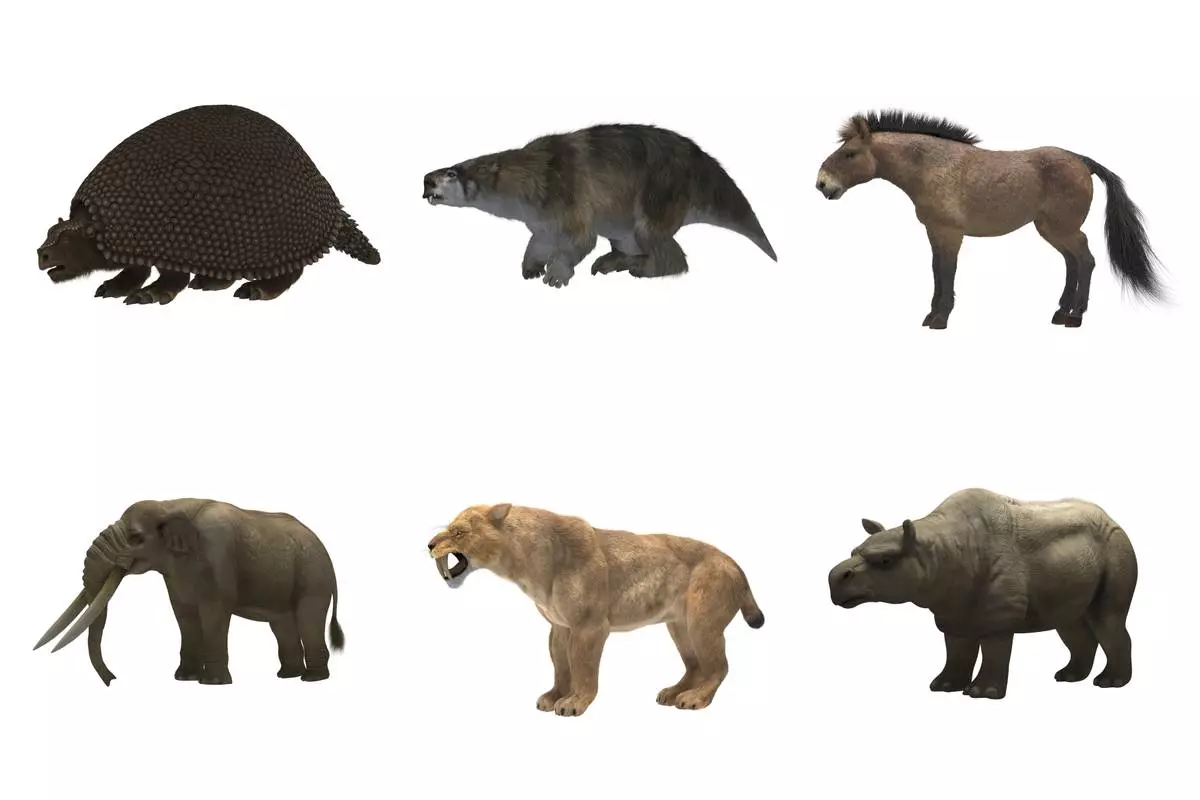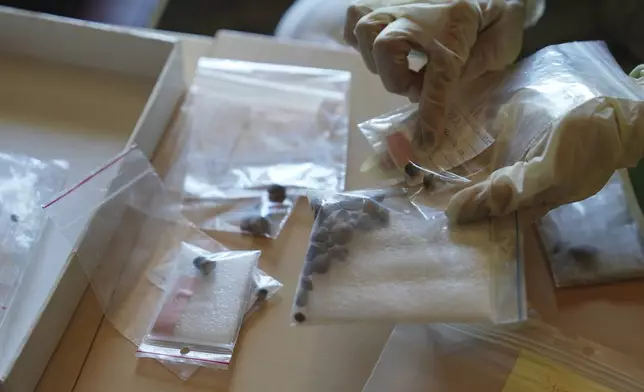SAO PAULO (AP) — Sloths weren’t always slow-moving, furry tree-dwellers. Their prehistoric ancestors were huge — up to 4 tons (3.6 metric tons) — and when startled, they brandished immense claws.
For a long time, scientists believed the first humans to arrive in the Americas soon killed off these giant ground sloths through hunting, along with many other massive animals like mastodons, saber-toothed cats and dire wolves that once roamed North and South America.
But new research from several sites is starting to suggest that people came to the Americas earlier — perhaps far earlier — than once thought. These findings hint at a remarkably different life for these early Americans, one in which they may have spent millennia sharing prehistoric savannas and wetlands with enormous beasts.
“There was this idea that humans arrived and killed everything off very quickly — what’s called ‘Pleistocene overkill,’” said Daniel Odess, an archaeologist at White Sands National Park in New Mexico. But new discoveries suggest that “humans were existing alongside these animals for at least 10,000 years, without making them go extinct."
Some of the most tantalizing clues come from an archaeological site in central Brazil, called Santa Elina, where bones of giant ground sloths show signs of being manipulated by humans. Sloths like these once lived from Alaska to Argentina, and some species had bony structures on their backs, called osteoderms — a bit like the plates of modern armadillos — that may have been used to make decorations.
In a lab at the University of Sao Paulo, researcher Mírian Pacheco holds in her palm a round, penny-sized sloth fossil. She notes that its surface is surprisingly smooth, the edges appear to have been deliberately polished, and there’s a tiny hole near one edge.
“We believe it was intentionally altered and used by ancient people as jewelry or adornment,” she said. Three similar “pendant” fossils are visibly different from unworked osteoderms on a table — those are rough-surfaced and without any holes.
These artifacts from Santa Elina are roughly 27,000 years old — more than 10,000 years before scientists once thought that humans arrived in the Americas.
Originally researchers wondered if the craftsmen were working on already old fossils. But Pacheco’s research strongly suggests that ancient people were carving “fresh bones” shortly after the animals died.
Her findings, together with other recent discoveries, could help rewrite the tale of when humans first arrived in the Americas — and the effect they had on the environment they found.
“There’s still a big debate,” Pacheco said.
Scientists know that the first humans emerged in Africa, then moved into Europe and Asia-Pacific, before finally making their way to the last continental frontier, the Americas. But questions remain about the final chapter of the human origins story.
Pacheco was taught in high school the theory that most archaeologists held throughout the 20th century. “What I learned in school was that Clovis was first,” she said.
Clovis is a site in New Mexico, where archaeologists in the 1920s and 1930s found distinctive projectile points and other artifacts dated to between 11,000 and 13,000 years ago.
This date happens to coincide with the end of the last Ice Age, a time when an ice-free corridor likely emerged in North America — giving rise to an idea about how early humans moved into the continent after crossing the Bering land bridge from Asia.
And because the fossil record shows the widespread decline of American megafauna starting around the same time — with North America losing 70% of its large mammals, and South America losing more than 80% — many researchers surmised that humans’ arrival led to mass extinctions.
“It was a nice story for a while, when all the timing lined up,” said paleoanthropologist Briana Pobiner at the Smithsonian Institution’s Human Origins Program. “But it doesn’t really work so well anymore.”
In the past 30 years, new research methods — including ancient DNA analysis and new laboratory techniques — coupled with the examination of additional archaeological sites and inclusion of more diverse scholars across the Americas, have upended the old narrative and raised new questions, especially about timing.
“Anything older than about 15,000 years still draws intense scrutiny,” said Richard Fariña, a paleontologist at the University of the Republic in Montevideo, Uruguay. “But really compelling evidence from more and more older sites keeps coming to light.”
In Sao Paulo and at the Federal University of Sao Carlos, Pacheco studies the chemical changes that occur when a bone becomes a fossil. This allows her team to analyze when the sloth osteoderms were likely modified.
“We found that the osteoderms were carved before the fossilization process” in “fresh bones” — meaning anywhere from a few days to a few years after the sloths died, but not thousands of years later.
Her team also tested and ruled out several natural processes, like erosion and animal gnawing. The research was published last year in the journal Proceedings of the Royal Society B.
One of her collaborators, paleontologist Thaís Pansani, recently based at the Smithsonian Institution, is analyzing whether similar-aged sloth bones found at Santa Elina were charred by human-made fires, which burn at different temperatures than natural wildfires.
Her preliminary results suggest that the fresh sloth bones were present at human campsites — whether burned deliberately in cooking, or simply nearby, isn’t clear. She is also testing and ruling out other possible causes for the black markings, such as natural chemical discoloration.
The first site widely accepted as older than Clovis was in Monte Verde, Chile.
Buried beneath a peat bog, researchers discovered 14,500-year-old stone tools, pieces of preserved animal hides, and various edible and medicinal plants.
“Monte Verde was a shock. You’re here at the end of the world, with all this organic stuff preserved," said Vanderbilt University archaeologist Tom Dillehay, a longtime researcher at Monte Verde.
Other archaeological sites suggest even earlier dates for human presence in the Americas.
Among the oldest sites is Arroyo del Vizcaíno in Uruguay, where researchers are studying apparent human-made “cut marks” on animal bones dated to around 30,000 years ago.
At New Mexico's White Sands, researchers have uncovered human footprints dated to between 21,000 and 23,000 years ago, as well as similar-aged tracks of giant mammals. But some archaeologists say it’s hard to imagine that humans would repeatedly traverse a site and leave no stone tools.
“They’ve made a strong case, but there are still some things about that site that puzzle me,” said David Meltzer, an archaeologist at Southern Methodist University. “Why would people leave footprints over a long period of time, but never any artifacts?"
Odess at White Sands said that he expects and welcomes such challenges. “We didn’t set out to find the oldest anything — we’ve really just followed the evidence where it leads,” he said.
While the exact timing of humans’ arrival in the Americas remains contested — and may never be known — it seems clear that if the first people arrived earlier than once thought, they didn’t immediately decimate the giant beasts they encountered.
And the White Sands footprints preserve a few moments of their early interactions.
As Odess interprets them, one set of tracks shows “a giant ground sloth going along on four feet” when it encounters the footprints of a small human who’s recently dashed by. The huge animal “stops and rears up on hind legs, shuffles around, then heads off in a different direction."
The Associated Press Health and Science Department receives support from the Howard Hughes Medical Institute’s Science and Educational Media Group. The AP is solely responsible for all content.

This illustration depicts giant sloths, humans and mastodons living alongside one another in central Brazil 27,000 years ago, during the Pleistocene period. (AP/Peter Hamlin)

Researcher Mírian Pacheco holds a round, penny-sized sloth fossil dated to around 27,000 years ago, at the University of São Paulo, Brazil, on Sept 2, 2024, saying that unlike most other specimens, its surface is surprisingly smooth, the edges appear to have been deliberately polished, and there’s a tiny hole near one edge. (AP Photo/Christina Larson)

This image provided by researchers shows an artifact made of bony material from a giant sloth discovered at a rock shelter in Brazil, recovered from archaeological layers dated to 25,000 to 27,000 years ago. (Thaís Pansani, Pierre Gueriau via AP)

Thaís Pansani holds a giant sloth rib bone from central Brazil dated to about 13,000 to 15,000 years ago, which is thought to be burned by human-made fire, in the Smithsonian's National Taphonomy Reference Collection in Washington, on July 11, 2024. (AP Photo/Mary Conlon)

Thaís Pansani examines giant sloth bones dated to about 25,000 to 27,000 years ago from central Brazil, some of which appear to be burned by human-made fire, at the Smithsonian Institution in Washington, on July 11, 2024. (AP Photo/Mary Conlon)

Thaís Pansani and Kay Behrensmeyer analyze a giant sloth rib bone from central Brazil, in the Smithsonian's National Taphonomy Reference Collection in Washington, D.C. on July 11, 2024. (AP Photo/Mary Conlon)

This photo provided by researchers shows the Santa Elina excavation site in the Mato Grosso state of Brazil. (Águeda Vilhena Vialou, Denis Vialou via AP)

This photo provided by researchers shows prehistoric drawings at the Santa Elina excavation site in the Mato Grosso state of Brazil. (Águeda Vilhena Vialou, Denis Vialou via AP)

This combination of illustrations provided by researchers in 2024 shows large animals which once roamed prehistoric North and South America. Top row from left, a glyptodon, a lestodon, and a horse. Bottom row from left, a mastodon, a saber-toothed cat and a toxodon. (Mauro Muyano via AP)

Paleontologist Thaís Pansani stands in front the reconstructed skeleton of a giant ground sloth at the Smithsonian National Museum of Natural History in Washington, on July 11, 2024. (AP Photo/Mary Conlon)

This photo provided by researchers shows fossils at the excavation site of Arroyo del Vizcaíno in Uruguay, where researchers have found evidence suggesting human occupation 30,000 years ago. (Martín Batallés via AP)

This illustration provided by researchers depicts a person carving an osteoderm from a giant sloth in Brazil about 25,000 to 27,000 years ago. (Júlia d'Oliveira via AP)






















